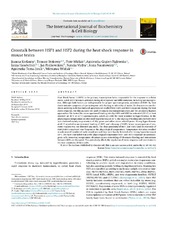| dc.contributor.author | Korfanty, Joanna | en_US |
| dc.contributor.author | Stokowy, Tomasz | en_US |
| dc.contributor.author | Widlak, Piotr | en_US |
| dc.contributor.author | Gogler-Piglowska, Agnieszka | en_US |
| dc.contributor.author | Handschuh, Luiza | en_US |
| dc.contributor.author | Podkowinski, Jan | en_US |
| dc.contributor.author | Vydra, Natalia | en_US |
| dc.contributor.author | Naumowicz, Anna | en_US |
| dc.contributor.author | Toma-Jonik, Agnieszka | en_US |
| dc.contributor.author | Widlak, Wieslawa | en_US |
| dc.date.accessioned | 2015-03-06T10:21:53Z | |
| dc.date.available | 2015-03-06T10:21:53Z | |
| dc.date.issued | 2014-12 | eng |
| dc.identifier.issn | 1357-2725 | |
| dc.identifier.uri | https://hdl.handle.net/1956/9474 | |
| dc.description.abstract | Heat Shock Factor 1 (HSF1) is the primary transcription factor responsible for the response to cellularstress, while HSF2 becomes activated during development and differentiation, including spermatogen-esis. Although both factors are indispensable for proper spermatogenesis, activation of HSF1 by heatshock initiates apoptosis of spermatogenic cells leading to infertility of males. To characterize mecha-nisms assisting such heat induced apoptosis we studied how HSF1 and HSF2 cooperate during the heatshock response. For this purpose we used chromatin immunoprecipitation and the proximity ligationapproaches. We looked for co-occupation of binding sites by HSF1 and HSF2 in untreated (32◦C) or heatshocked (at 38◦C or 43◦C) spermatocytes, which are cells the most sensitive to hyperthermia. At thephysiological temperature or after mild hyperthermia at 38◦C, the sharing of binding sites for both HSFswas observed mainly in promoters of Hsp genes and other stress-related genes. Strong hyperthermiaat 43◦C resulted in an increased binding of HSF1 and releasing of HSF2, hence co-occupation of pro-moter regions was not detected any more. The close proximity of HSF1 and HSF2 (and/or existence ofHSF1/HSF2 complexes) was frequent at the physiological temperature. Temperature elevation resultedin a decreased number of such complexes and they were barely detected after strong hyperthermia at43◦C. We have concluded that at the physiological temperature HSF1 and HSF2 cooperate in spermato-genic cells. However, temperature elevation causes remodeling of chromatin binding and interactionsbetween HSFs are disrupted. This potentially affects the regulation of stress response and contributes tothe heat sensitivity of these cells. | en_US |
| dc.language.iso | eng | eng |
| dc.publisher | Elsevier | eng |
| dc.rights | Attribution-NonCommercial-NoDerivs CC BY-NC-ND | eng |
| dc.rights.uri | http://creativecommons.org/licenses/by-nc-nd/3.0/ | eng |
| dc.subject | Heat shock response | eng |
| dc.subject | Spermatogenesis | eng |
| dc.subject | ChIP-Seq | eng |
| dc.title | Crosstalk between HSF1 and HSF2 during the heat shock response in mouse testes | en_US |
| dc.type | Peer reviewed | |
| dc.type | Journal article | |
| dc.date.updated | 2015-03-06T07:27:56Z | |
| dc.description.version | publishedVersion | en_US |
| dc.rights.holder | Copyright 2014 The Authors | |
| dc.identifier.doi | https://doi.org/10.1016/j.biocel.2014.10.006 | |
| dc.identifier.cristin | 1211383 | |
| dc.source.journal | International Journal of Biochemistry and Cell Biology | |
| dc.source.40 | 57 | |
| dc.source.pagenumber | 76-83 | |

